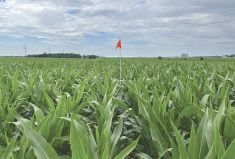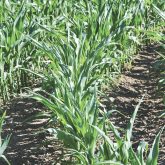When commodity prices are higher than normal, it’s sometimes hard to switch gears and think about corn production using a metric other than bushels. But precision agriculture techniques can also be used to maximize feed characteristics for meat and milk production.
At the 2022 edition of Canada’s Outdoor Farm Show, seed companies were distributing their catalogues for 2023, and several had what could be described as “more robust” listings for silage-specific hybrids. It could be a shift in trends, or as some have suggested, part of an evolutionary stage of the corn feed market.
It’s been more than 20 years since genetically modified hybrids became the norm and since then, some in the seed trade have insisted that “multifunctional” hybrids serve both the grain and feed sectors equally well. Yet in light of the listings of silage-specific hybrids from 2023 seed guides, it’s evident there is a change in the corn seed market. There are livestock producers who want better digestibility and palatability for their animals, opting for quality ahead of quantity.
Read Also

Could crop sharing be a viable option for your farm?
Crop sharing could be a good option for young and beginning farmers.
For Rick Van Laecke, the move is a sign of greater precision in the corn market.
“Growers’ decisions are more science-based now; they’re looking at more data; they have more information at their fingertips,” says Van Laecke, president of Horizon Seeds.
“In some ways, it seems as though there’s renewed interest but I think it’s the fact they’re more precise on their needs and they know what their goals are, and it’s caused more demand for silage-specific.”
There’s also animal health to consider. Van Laecke notes that breeders have been pushed to make standability, yield and test weights the three main priorities. But two of those are characteristics of a bad silage hybrid — tough stalks and heavy test weights.
“You don’t want that hard kernel cap. You want that energy to be extractable by the cow and you don’t want that bamboo-type stalk for the cow to chew on. There’s more work done on the social aspect of the herd and having happy cows. But they’re not happy if their mouths are sore, and breeders are creating hybrids that stand well yet cause combine and tractor tires to wear prematurely because they’re too rigid and sharp. And now there’s a desire to feed that to a cow?”
Shifting demands
Jacquie MacCormack is Horizon Seeds’s southwestern business lead, with a background in the feed market. Like Van Laecke, she sees the shift in livestock producers’ demands for quality instead of quantity. It may not be a sweeping change but for higher-end dairy and beef producers, she says there’s a preference for digestibility over tonnage.
“The better it is for digestibility, the less the producer has to supplement with other things, which makes feeding a lot more cost-effective.”

MacCormack says digestibility and palatability are the main goals for dairy producers in particular, just for the efficiency in milk production. Value is always seen as what’s coming out of the cow.
“As a dairy producer, you can see when you hit the different spot in your bunk or the different spot in the silo where you switched hybrids. You can see that immediate effect when you’re milking two or three times a day because the input change is right there. That’s where the dairy industry really values it because they have that instant feedback.”
MacCormack says it’s striking a balance: did you get more milk out of that cow and feed less? Or did you have to feed more to get the same amount?
Balancing rations has become more of a focus for nutritionists, a change from the past when the pledge was, “We can balance anything.”
“You can balance anything but the cost of throwing different premixes and min- erals and outside sources at it doesn’t really weigh out,” MacCormack says. “But if you have a good silage hybrid to begin with, you’re better off in the end.”
In the thick of things
Among retailers and advisors, the picture of silage-specific hybrids also seems to fall into the “quality versus quantity” discussion, although Steph Berlett often fields requests for both. Those feeding corn are paying close attention to which hybrids are best for their needs, but they also look for higher yields.
“They will not sacrifice much tonnage for better quality, but I would say there is a delicate balancing act,” says Berlett, a certified crop advisor (CCA) with Brussels Agromart, adding some will forgo a bit of one or the other.
“I’ve seen a more concentrated effort in recent years to develop silage-specific data and there’s been more feedback than just calling it a ‘dual hybrid’ or saying, ‘it’s a tall plant, so it’s good for silage.’ That’s not cutting it anymore, especially when they have the technology in the barns to be tracking their feed data, so they’re starting to ask more detailed questions about their hybrids’ abilities.”
Berlett concedes silage-specific is an added layer of management. Seed companies are challenged in their breeding programs, retailers face bagging and storage requirements and staying current on trait approvals, and livestock producers often have a higher focus on animal nutrition versus a reflex-like desire for higher yields. Since she works more on the agronomics of planting and growing hybrids, she has to be more diligent in her advice, always learning more about the producer’s needs for animal health.
“In that regard, there needs to be better integration or communication between nutritionists and crop advisors,” says Berlett, noting that hybrid selection for a dairy or beef producer has to be driven from the nutritionist’s side. “We can’t go out and push ‘Hybrid A’ without understanding the implications to the grower’s feed sample.”
Other challenges
Balancing nutrition with yield is not the only issue facing producers and their advisors. Hybrid options, size of operations, storage capacity, agronomy, and disease and pest management are all parts of the equation.
Robert Moloney maintains silage-specific hybrids are a niche market, except for those producers who are dedicated to growing them.
“Animal intake tends to be higher with leafy hybrids,” says Moloney, a CCA with Boyd’s Farm Supply in Fordwich, Ont. “But that also means more acres to grow and more space to hold the feed. A higher-quality feed typically means you need less storage and with the increasing size of operations, that’s a consideration.”
On the quality side, hybrids with a trait like brown mid-rib (BMR) increase digestibility but they need more acres due to lower yield or other challenges such as lodging or poor disease resistance. That can be an issue for plant breeders: although they’re breeding for many of the same characteristics such as standability, silage-specific is another set of traits and genetics that must be included.
“The problem with silage-specific is you don’t have an option for taking it as grain, so extra plants in the field would be wasted,” Moloney says. “The logistics of producing a small pile of silage-specific hybrids — with isolation requirements for seed production, logistics of small batches, physical seed bag inventory if they want different branding — are probably also limiting.”
– This article was originally published in the January 2023 issue of the Corn Guide.
















